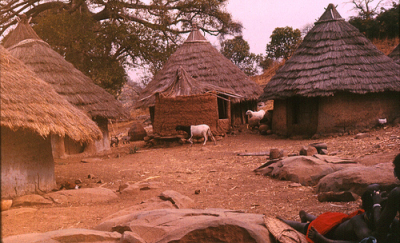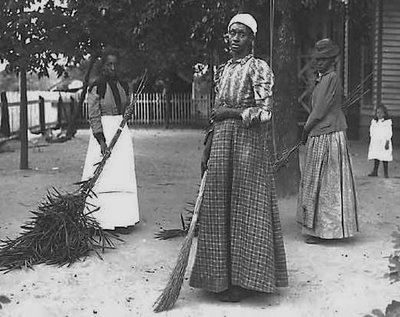
African roots of current African-American gardens
 Westmacott
perused accounts and photos of western Africa from the eighteenth and
nineteenth centuries, searching for similarities between historical
African gardens and current
African-American
gardens in the rural South. Western Africa is a
diverse area, ranging from rainforest to subtropical desert, and the
agricultural heritage of west Africans is similarly diverse. Some
people were nomadic herders, others had grain-based diets much like our
own, while still others practiced what Westmacott called "vegeculture"
but which I would call forest
gardening --- edible
trees, roots, vines,
and grains all mashed together into one space.
Westmacott
perused accounts and photos of western Africa from the eighteenth and
nineteenth centuries, searching for similarities between historical
African gardens and current
African-American
gardens in the rural South. Western Africa is a
diverse area, ranging from rainforest to subtropical desert, and the
agricultural heritage of west Africans is similarly diverse. Some
people were nomadic herders, others had grain-based diets much like our
own, while still others practiced what Westmacott called "vegeculture"
but which I would call forest
gardening --- edible
trees, roots, vines,
and grains all mashed together into one space.
West Africans who grew
what we now consider traditional gardens
typically clustered their houses into fenced compounds. They
grazed any livestock they might happen to have outside during the day,
but took the animals in at night. Crops were grown outside the
village compound in intensively tilled and manured land, while trees
with edible fruits (like bananas, coconuts, and mangos) were planted
within the village for shade.
As you can probably
guess from my previous lunchtime series on Chinese
and Central
American traditional gardening practices, I was intrigued
by this look into traditional African agriculture. But very few
of the African practices seemed to carry over to the United
States. Shade trees are ubiquitous in African-American yards in
the South, but the trees are not edibles, and there is no sign of
forest gardening.

The one aspect of the
southern gardens that Westmacott felt confident
tracing back to Africa was the swept yard. Although inexpensive
motorized lawnmowers are now pushing swept yards into history, many of
the old timey African-American families in Westmacott's study stuck to
the traditional bare earth yard. The families spent time every
day
hoeing weeds out of the yard, then sweeping every bit of trash and
debris out of the living space. The result was an area where
children could play and adults could easily sit and talk, without
danger of snakes or ticks. The practice can be clearly traced
back to Africa, not only because Africans still keep up swept yards,
but also because bare earth yards just don't work in more temperate
climates. In areas without long dry seasons a swept yard will
turn to mud and become impassable for a large portion of the
year. I guess we won't be making a swept earth yard here!
| This post is part of our African-American Gardens and Yards in the
Rural South lunchtime series.
Read all of the entries: |
Want more in-depth information? Browse through our books.
Or explore more posts by date or by subject.
About us: Anna Hess and Mark Hamilton spent over a decade living self-sufficiently in the mountains of Virginia before moving north to start over from scratch in the foothills of Ohio. They've experimented with permaculture, no-till gardening, trailersteading, home-based microbusinesses and much more, writing about their adventures in both blogs and books.
Want to be notified when new comments are posted on this page? Click on the RSS button after you add a comment to subscribe to the comment feed, or simply check the box beside "email replies to me" while writing your comment.
- Remove comment
- Remove comment
